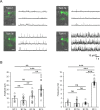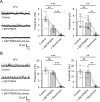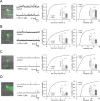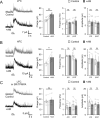Cannabinoid Signaling Selectively Modulates GABAergic Inhibitory Input to OFF Bipolar Cells in Rat Retina
- PMID: 32150246
- PMCID: PMC7401570
- DOI: 10.1167/iovs.61.3.3
Cannabinoid Signaling Selectively Modulates GABAergic Inhibitory Input to OFF Bipolar Cells in Rat Retina
Abstract
Purpose: In the mammalian retina, cannabinoid type 1 receptors (CB1Rs) are well-positioned to alter inhibitory synaptic function from amacrine cells and, thus, might influence visual signal processing in the inner retina. However, it is not known if CB1R modulates amacrine cells feedback inhibition at retinal bipolar cell (BC) terminals.
Methods: Using whole-cell voltage-clamp recordings, we examined the pharmacological effect of CB1R activation and inhibition on spontaneous inhibitory postsynaptic currents (sIPSCs) and glutamate-evoked IPSCs (gIPSCs) from identified OFF BCs in light-adapted rat retinal slices.
Results: Activation of CB1R with WIN55212-2 selectively increased the frequency of GABAergic, but not glycinergic sIPSC in types 2, 3a, and 3b OFF BCs, and had no effect on inhibitory activity in type 4 OFF BCs. The increase in GABAergic activity was eliminated in axotomized BCs and can be suppressed by blocking CB1R with AM251 or GABAA and GABAρ receptors with SR-95531 and TPMPA, respectively. In all OFF BC types tested, a brief application of glutamate to the outer plexiform layer elicited gIPSCs comprising GABAergic and glycinergic components that were unaffected by CB1R activation. However, blocking CB1R selectively increased GABAergic gIPSCs, supporting a role for endocannabinoid signaling in the regulation of glutamate-evoked GABAergic inhibitory feedback to OFF BCs.
Conclusions: CB1R activation shape types 2, 3a, and 3b OFF BC responses by selectively regulate GABAergic feedback inhibition at their axon terminals, thus cannabinoid signaling might play an important role in the fine-tuning of visual signal processing in the mammalian inner retina.
Conflict of interest statement
Disclosure:
Figures










Similar articles
-
Cannabinoid CB1 receptor signaling dichotomously modulates inhibitory and excitatory synaptic transmission in rat inner retina.Brain Struct Funct. 2016 Jan;221(1):301-16. doi: 10.1007/s00429-014-0908-4. Epub 2014 Oct 2. Brain Struct Funct. 2016. PMID: 25273281
-
Suppression of outward K⁺ currents by WIN55212-2 in rat retinal ganglion cells is independent of CB1/CB2 receptors.Neuroscience. 2013 Dec 3;253:183-93. doi: 10.1016/j.neuroscience.2013.08.056. Epub 2013 Sep 5. Neuroscience. 2013. PMID: 24013008
-
Control of cannabinoid CB1 receptor function on glutamate axon terminals by endogenous adenosine acting at A1 receptors.J Neurosci. 2010 Jan 13;30(2):545-55. doi: 10.1523/JNEUROSCI.4920-09.2010. J Neurosci. 2010. PMID: 20071517 Free PMC article.
-
Multiple pathways of inhibition shape bipolar cell responses in the retina.Vis Neurosci. 2011 Jan;28(1):95-108. doi: 10.1017/S0952523810000209. Epub 2010 Oct 8. Vis Neurosci. 2011. PMID: 20932357 Free PMC article. Review.
-
Receptor targets of amacrine cells.Vis Neurosci. 2012 Jan;29(1):11-29. doi: 10.1017/S0952523812000028. Vis Neurosci. 2012. PMID: 22310370 Free PMC article. Review.
Cited by
-
Tonic Endocannabinoid Levels Modulate Retinal Signaling.Int J Environ Res Public Health. 2022 Sep 30;19(19):12460. doi: 10.3390/ijerph191912460. Int J Environ Res Public Health. 2022. PMID: 36231760 Free PMC article.
-
The endocannabinoid system and ophthalmic pathologies: a review of molecular mechanisms and its implications for clinical practice.Front Med (Lausanne). 2025 Feb 5;12:1500179. doi: 10.3389/fmed.2025.1500179. eCollection 2025. Front Med (Lausanne). 2025. PMID: 39975680 Free PMC article. Review.
-
Non-canonical type 1 cannabinoid receptor signaling regulates night visual processing in the inner rat retina.iScience. 2024 May 7;27(6):109920. doi: 10.1016/j.isci.2024.109920. eCollection 2024 Jun 21. iScience. 2024. PMID: 38799553 Free PMC article.
-
Serotonin regulates in a cell-type specific manner light-evoked response and synaptic activity in mouse retinal ganglion cells.Biol Res. 2025 Mar 4;58(1):11. doi: 10.1186/s40659-025-00594-6. Biol Res. 2025. PMID: 40033464 Free PMC article.
-
Cannabinoids Regulate Sensory Processing in Early Olfactory and Visual Neural Circuits.Front Neural Circuits. 2021 Jul 7;15:662349. doi: 10.3389/fncir.2021.662349. eCollection 2021. Front Neural Circuits. 2021. PMID: 34305536 Free PMC article. Review.
References
-
- Hashimotodani Y, Ohno-Shosaku T, Kano M. Endocannabinoids and synaptic function in the CNS. Neuroscientist. 2007; 13: 127–137. - PubMed
-
- Bouskila J, Burke MW, Zabouri N, Casanova C, Ptito M, Bouchard JF. Expression and localization of the cannabinoid receptor type 1 and the enzyme fatty acid amide hydrolase in the retina of vervet monkeys. Neuroscience. 2012; 202: 117–130. - PubMed
Publication types
MeSH terms
Substances
LinkOut - more resources
Full Text Sources
Research Materials

